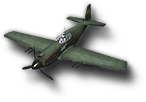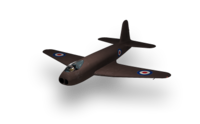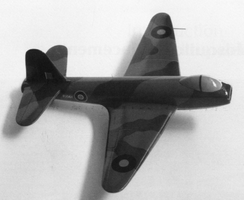Westland P.1056
P.1056
Totals
| 2600000 Prix |
| 600 Capacité de survie |
| 9320 kgPoids |
| 601.3 Dégâts |
Speed
| 1939.4 Vitesse |
| 820 km/hVitesse max. au ras du sol |
| 820 km/hVitesse max. à altitude idéale |
| 2000 mAltitude optimale |
| 920 km/hVitesse en piqué |
| 108.3 m/sTaux de montée |
| 260 km/hVitesse de décrochage |
| 609 km/hVitesse optimale |
Mobility
| 77.8 Contrôlabilité |
| 14.9 sTemps moyen de rotation 360° |
| 70 °/sTaux de roulis |
| 903.6 Maniabilité |
VIII

2600000

Moteur
| Rang | Moteur | Puissance du moteur, ch / Poussée | Type | Poids, kg | Prix, |
|---|---|---|---|---|---|
| VIII | Metrovick F.2/4 | 1814 | avion à réaction | 1460 | 118000 |
| IX | NAME_MODULE_METROVICK-F-8_SPEC_TOP_WESTLAND-P-1056_1 | 2722 | avion à réaction | 1500 | 149000 |
| IX | Metrovick F.8 | 2722 | avion à réaction | 1500 | 149000 |

Cellule d'avion
| Rang | Cellule d'avion | Capacité de survie | Poids, kg | Prix, |
|---|---|---|---|---|
| VIII | Westland P.1056 | 600 | 7500 | 145000 |

Armement du carénage
| Rang | Mitrailleuse | Calibre | Vitesse initiale, m/s | Dégâts | Cadence de tir, coups/min | Poids, kg | Prix, |
|---|---|---|---|---|---|---|---|
| VIII | 20 mm Hispano Mk.V* (C) | 20 | 1760 | 130 | 420 | 90 | 54000 |

Armement des ailes
| Rang | Mitrailleuse | Calibre | Vitesse initiale, m/s | Dégâts | Cadence de tir, coups/min | Poids, kg | Prix, |
|---|---|---|---|---|---|---|---|
| VIII | 20 mm Hispano Mk.V* (A) | 20 | 1760 | 130 | 420 | 90 | 48000 |
| IX | 40 mm Rolls-Royce BH (A) | 40 | 1120 | 240 | 120 | 120 | 66000 |

Armement extérieur
| Rang | Bombes | Rayon des dégâts, m | Dégâts | Poids, kg | Prix, |
|---|---|---|---|---|---|
| VIII | WEAPON_NAME_1000FN_SPEC_TOP_WESTLAND-P-1056_1 | 90 | 6000 | 454 | 1800 |

Armement extérieur
| Rang | Roquettes | Rayon des dégâts, m | Dégâts | Poids, kg | Prix, |
|---|---|---|---|---|---|
| VIII | WEAPON_NAME_RP-3-GP_SPEC_TOP_WESTLAND-P-1056_1 | 35 | 1500 | 37 | 800 |

Compatible Equipment
Compatible Consumables
Informations Historiques
In March 1944 Westland Aircraft's Technical Director, W E W Petter, had completed a private venture design study for a high-speed twin jet-powered fighter-homber in two versions. This followed discussions between the company and the Ministry of Aircraft Production (MAP). The P. 1056 had the tailweel arrangement used most piston aircraft. Power was supplied by a pair of 3.500Ib (15.6kN) Metropolitan Vickers (MetroYick) F.2/4 Beryl axial jet engines mounted side-by-side in the centre fuselage and fed by a large nose intake. The P. 1056 had two crew seated side-by-side in a cockpit placed close to the nose to give an excellent view, four 20mm cannon mounted in the lower forward fuselage and a large internal bomb bay situated behind the engines and beneath their exhaust pipes for carrying up to six bombs or other loads including rocket projectiles.
The project generated much interest and a mock-up was built of the nose and central fuselage, while Petter had on his desk a scale model complete with bombs, engines and other internal fittings. The project died when Petter left the Westland company
Historical Gallery
Sources et Liens Externes
| Fighters | IIBristol Bulldog • IIIBristol Type 133 • IIIHawker P.V.3 • IIISupermarine Type 224 • IVBristol Type 146 • IVFairey Fantome • IVHawker Hurricane Mk. Ia • VCAC CA-12 Boomerang • VMiles M.20 • VSupermarine Spitfire I • VSupermarine Spitfire Mk Ia • VVickers Venom • VINorth American Mustang Mk.I • VINorth American Mustang IA • VISupermarine Spitfire V • VISupermarine Spitfire Vb IM • VISupermarine Spitfire Vb • VIIGloster Meteor F. I • VIISupermarine Spitfire IX • VIIISupermarine Spitfire XIV • VIIIDe Havilland DH.100 Vampire F.1 • IXSupermarine Attacker • XSupermarine Swift |
| Heavy Fighters | IVBristol Blenheim F • VBristol Beaufighter • VBristol Beaufighter V • VIDe Havilland 98 Mosquito • VIIDe Havilland 103 Hornet • VIIIWestland P.1056 • IXGloster P.228 • XGloster Javelin |
| Attack Aircraft | IIICAC CA-1 Wirraway |
Heavy Fighters
Catégorie :


